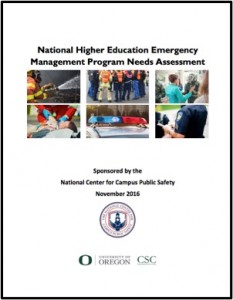Authored by the National Center for Campus Public Safety

- What is needed to improve emergency management at IHEs?
- Where are resources currently being deployed on campuses?
- Where are the gaps in resources and information?
- What is the best way to fill these gaps and improve campus public safety?
- Re-fund the U.S. Department of Education’s Emergency Management for Higher Education (EMHE) grant program.
- Establish an emergency management curriculum and training program targeting executive leadership.
- Establish an ad-hoc working group focused on communication and resource coordination between campus emergency management officials and federal agency representatives.
- Encourage designation of IHE emergency management coordinators at the state or regional level.
- Establish an ad hoc working group to develop a program maturity model for institutions’ EMPs.
To download the National Higher Education Emergency Management Program Needs Assessment report Click Here.
